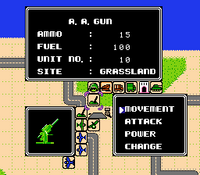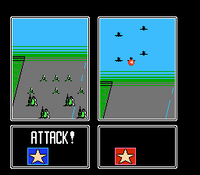Software:Desert Commander
| Desert Commander | |
|---|---|
 | |
| Developer(s) | Kemco |
| Publisher(s) | Kemco |
| Composer(s) | Hiroyuki Masuno |
| Platform(s) | Nintendo Entertainment System |
| Release | |
| Genre(s) | Turn-based strategy |
| Mode(s) | Single-player, multiplayer |
Desert Commander[lower-alpha 1] is a 1988 turn-based strategy video game developed and published by Kemco in Japan and North America for the Nintendo Entertainment System. It is themed after the North African theatre of World War II in the 1940s, where players take command of the Allied Forces led by George S. Patton and Bernard Montgomery to fight against the Axis Powers led by Erwin Rommel. Its gameplay consists of moving units into positions to confront enemies in turn-based encounters determined by multiple factors, replenishing units with resources in order to occupy the enemy headquarters or destroy all enemy forces. The title garnered positive reception from critics; Reviewers praised several aspects such as the presentation, visuals, controls, challenge and balance of strategy and action, though others criticized certain design choices while fan reception proved to be mixed in Japan.
Gameplay
Desert Commander is a World War II-themed turn-based strategy game where players assume command of the Allied Forces led by Generals George S. Patton and Bernard Montgomery across five increasingly difficult scenarios that take place in the 1940s, each one giving a pre-determined set number of units to use, to fight against the Axis Powers led by Erwin Rommel.[1][2][3][4][5] Available modes of play include the main single-player campaign and a two-player versus mode.[4][5]
The main gameplay objective is to either occupy the enemy headquarters or destroy all opposing forces on the playfield and the player that does so first wins.[3][4] Players command their units on a map, using a command window function, and each unit have different mobility range that varies according to their type except aircraft units in addition of possessing different shooting range.[4][5] Terrain plays an important role during battle sequences, as it can affect the outcome of encounters in terms of terrestrial unit's movility, attack and defense (except for aircraft).[3][4][5] Each scenario has no time limit and gives a different set number of units to use, which the players can mix and match between the different types without going over that limit.[3][4][5] When playing against the CPU, the computer will be given a different ratio of units to command from the player. On the easiest scenario, both the player and the CPU have the same number of units, while in all others the CPU will have more than the player. There is no variance in artificial intelligence, so the only thing that makes the later maps harder is the larger number of units the CPU has. When in a one-player game, the second controller can be used to modify the CPU forces.[4] Prior to a two-player match, players can also customize the number of units at their disposal.[3][4][5]
The player's force consists of nine different types of units and one headquarters unit (which is a unit by itself and also can be used to attack).[4] A certain unit is particularly strong or weak against a particular opponent, performing average against every other unit type. Units cannot be produced, but players can replenish them by landing at the appropriate buildings or be resupplied by a supply truck; for example, all aircraft must stop at an airport in order to recharge their fuel and ammo supply.[3][4][5] Transport units are also available to carry infantry units across the map.[4]
Synopsis
World War II began when the German army of Adolf Hitler invaded Poland through the use of the infamous blitzkrieg technique. By June 1940, France formally surrendered to Nazi Germany; making Germany the strongest nation in Continental Europe. Benito Mussolini, the dictator of Fascist Italy had signed a military alliance with Germany at the time. He looked at this opportunity to transform the Mediterranean Sea into an "Italian Lake." Axis forces managed to deliver their invading troops to Egypt by September 1940. However, the Italian army was instantly defeated by the British counterattackers who had a duty to protect Egypt. Germany was determined to help Italy win their conflict while preparing for their fateful campaign in the Soviet Union at the same time.[2][3]
Development and release
Desert Commander was first released in Japan by Kemco on April 28, 1988 and later in North America on June 1989.[6][7] The soundtrack was composed by Hiroyuki Masuno.[8] Prior to its launch in the North American market, the game was titled Desert Tank Force before being renamed to Desert Commander and was showcased multiple times at the Summer and Winter editions of Consumer Electronics Show from 1988 to 1989 respectively.[1][9][10] In the original Japanese version, players choose between the Allied Forces of Generals George S. Patton and Bernard Montgomery, and the Axis Powers of General Erwin Rommel.[2] For the North American release, the factions were not named and the conflict remained opaque.[4] On April 24, 2013, the title's soundtrack was included as part of the ROM Cassette Disc In KEMCO music album by City Connection's Clarice Disk label.[8][11]
Reception
| Reception | ||||||||||||||
|---|---|---|---|---|---|---|---|---|---|---|---|---|---|---|
| ||||||||||||||
Desert Commander was met with positive reception from critics.[6] Nintendo Power praised the audiovisual presentation, controls, challenge and thematic.[13] Computer Entertainer recommended the game for strategy fans and commended its visual presentation, stating that "Wargaming fans have long been out there and now Nintendo wargamers have something to bite into."[14] Game Players' William R. Trotter regarded it as entertaining, giving positive comments to the simulation of terrain effect on movement but criticized the cartoon-like battle sequences and various drawbacks.[16] Brazilian magazine VideoGame (magazine) (pt) also gave positive remarks to the difficulty, graphics and sound design.[15] However, public reception was mixed: in a poll taken by Japanese publication Family Computer Magazine, it received a score of 17.19 out of 30.[17] AllGame's Skyler Miller noted its balance between strategy and action, quick turns and easy-to-use interface in a positive light, although he remarked that the game is not very detailed for hardcore players, stating that "Desert Commander is a good choice for board game fans and those who like more thoughtful entertainment."[12]
Notes
References
- ↑ 1.0 1.1 "Sneak Peek: CES Video-Games Preview". VideoGames & Computer Entertainment (Larry Flynt Publications) (5): 38–42. June 1989. https://retrocdn.net/index.php?title=File%3AVG%26CE_US_05.pdf&page=41. Retrieved 2021-01-03.
- ↑ 2.0 2.1 2.2 "砂漠の狐 - 「FCのゲーム制覇しましょ」まとめ - atwiki(アットウィキ)" (in ja). @wiki. AtWiki, Inc.. March 8, 2014. https://w.atwiki.jp/famicomall/pages/949.html.
- ↑ 3.0 3.1 3.2 3.3 3.4 3.5 3.6 (in ja) 砂漠の狐 戦車戦略 完全攻略テクニックブック. Tokuma Shoten. April 1, 1988. pp. 1–55. ISBN 978-4886580887.
- ↑ 4.00 4.01 4.02 4.03 4.04 4.05 4.06 4.07 4.08 4.09 4.10 4.11 Desert Commander instruction booklet (Nintendo Entertainment System, US)
- ↑ 5.0 5.1 5.2 5.3 5.4 5.5 5.6 Bateman, Selby (October–November 1989). "First Looks: Desert Commander". Game Player's Buyer's Guide to Nintendo Games (Signal Research) 2 (5): 92–93.
- ↑ 6.0 6.1 6.2 "NEW GAMES CROSS REVIEW: 戦車戦略 砂漠の狐". Famitsu (ASCII Corporation). 1989. https://www.famitsu.com/games/t/19885/reviews/. Retrieved 2021-01-02.
- ↑ "NES Games" (PDF). Nintendo. http://www.nintendo.com/consumer/downloads/nes_games.pdf.
- ↑ 8.0 8.1 "CDGM-10011 | ROM Cassette Disc In KEMCO". vgmdb.net. VGMdb. https://vgmdb.net/album/38125.
- ↑ "1988 Summer CES: An Overview - Torrent of Titles from Nintendo Licensees — Kemco-Seika Corporation". Computer Entertainer 7 (3): 12. June 1988. https://retrocdn.net/index.php?title=File:ComputerEntertainer_US_Vol.7_03.pdf&page=12. Retrieved 2021-01-03.
- ↑ "The Video Game Update: Nintendo Licensees Show Games; New Licensees Announced - Seika Corp. (Kemko-Seika)". Computer Entertainer 7 (10): 10. January 1989. https://retrocdn.net/index.php?title=File:ComputerEntertainer_US_Vol.7_10.pdf&page=10. Retrieved 2021-01-03.
- ↑ "Rom Cassette Disc In KEMCO" (in ja). Clarice Shop. City Connection. April 2013. https://claricedisc.shop-pro.jp/?pid=56319723.
- ↑ 12.0 12.1 Miller, Skyler (1998). "Desert Commander - Review". AllGame. All Media Network. http://www.allgame.com/game.php?id=15375&tab=review.
- ↑ 13.0 13.1 "Video Shorts: Desert Commander from Kemco-Seika". Nintendo Power (Nintendo of America) (5): 81. March–April 1989.
- ↑ 14.0 14.1 "Nintendo Software: Desert Commander". Computer Entertainer 8 (6): 11. September 1989. https://retrocdn.net/index.php?title=File:ComputerEntertainer_US_Vol.8_06.pdf&page=11.
- ↑ 15.0 15.1 "Sistema Nintendo: Desert Commander". VideoGame (magazine) (pt) (Editora Sigla) (3): 40. May 1991. https://archive.org/stream/VideoGame_Ano_1_Numero_03_1991-05_Sigla_Editora_BR_pt#page/n39/mode/1up.
- ↑ R. Trotter, William (November 1989). "Nintendo Reviews: Desert Commander". Game Players (Signal Research) (5): 100. https://archive.org/details/Game_Players_Issue_05_November_1989/page/n103/mode/1up.
- ↑ "Famicom ROM Cassette All Catalog '91 全787本 5月10日号特別付録 - 戦車戦略 砂漠の狐". Famimaga (Tokuma Shoten) 7 (9): 307. 10 May 1991.
External links
- Desert Commander at GameFAQs
- Desert Commander at Giant Bomb
- Desert Commander at MobyGames
 |



